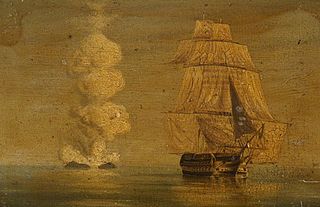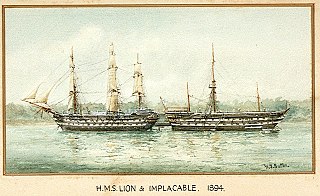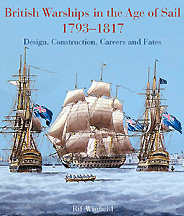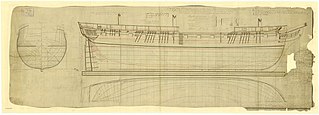Related Research Articles
Thirteen vessels of the Royal Navy have borne the name HMS Mohawk, after the Mohawk, an indigenous tribe of North America:

The Nelson-class ships of the line were a class of three 120-gun first rates, designed for the Royal Navy as a joint effort between the two Surveyors of the Navy at the time, Robert Seppings and Joseph Tucker.

The Black Prince-class ships of the line were a class of four 74-gun third rates built for the Royal Navy in the closing years of the Napoleonic War. The draught for this class of ship was essentially a reduced version of the captured Danish ship Christian VII.
HMS Centurion was a 80-gun second rate Vanguard-class ship of the line built for the Royal Navy in the 1840s.

HMS Lion was a 80-gun second rate Vanguard-class ship of the line built for the Royal Navy in the 1840s. She was fitted with steam propulsion in 1858–1859. In 1871 Lion was converted into a training ship at HM Dockyard, Devonport. The ship was sold for scrap in 1905.

HMS Colossus was a 80-gun second rate Vanguard-class ship of the line built for the Royal Navy in the 1840s. The ship was fitted with steam propulsion in 1854–1855, and was sold for scrap in 1867.

HMS Halifax was a ship-rigged sloop of the Merlin class built in 1806 for the British Royal Navy at the Naval Yard in Halifax, Nova Scotia. Built to fill a pressing need for coastal patrol sloops on the North American Station, Halifax was one of the few warships built at Halifax Naval Yard in the Age of Sail as the yard's primary function was supply and refit.

British Warships in the Age of Sail is a series of four books by maritime historian Rif Winfield comprising a historical reference work providing details of all recorded ships that served or were intended to serve in the (British) Royal Navy from 1603 to 1863. Similar volumes dealing with other navies during the Age of Sail have followed from the same publisher.

HMS Galatea was a Jason-class 26-gun, sixth-rate, wooden screw frigate in the Royal Navy, launched in 1859 and broken up 1883.

HMS Orpheus was a 36-gun Apollo-class fifth-rate frigate of the Royal Navy launched in 1809 from Deptford Dockyard. She was broken up in 1819.

HMS Magicienne was the lead ship of her class of two 16-gun, steam-powered second-class paddle frigates built for the Royal Navy in the 1850s. Commissioned in 1853 she played a small role in the Crimean War of 1854–1855 and was sold for scrap in 1866.

The Albacore-class gunboat, also known as "Crimean gunboat", was a class of 98 gunboats built for the Royal Navy in 1855 and 1856 for use in the 1853-1856 Crimean War. The design of the class, by W. H. Walker, was approved on 18 April 1855. The first vessels were ordered the same day, and 48 were on order by July; a second batch, which included Surly, were ordered in early October.

HMS Thetis was a 46-gun Leda-class fifth-rate frigate built for the Royal Navy during the 1810s. She was first commissioned in 1823 and was assigned to the South America Station three years later. The ship was wrecked in 1830 off Cape Frio, Brazil, with the loss of 22 crewmen; most of her cargo of bullion was successfully salvaged.

HMS Arethusa was a 46-gun Leda-class fifth-rate frigate built for the Royal Navy during the 1810s. The ship was never commissioned and was converted into a lazarette in 1836. She was renamed HMS Bacchus in 1844 and was further converted into a coal hulk in 1851–52. The ship was sold for scrap in 1883.
HMS Wizard was a 10-gun Cherokee-class brig-sloop built for the Royal Navy during the 1820s. She was wrecked in 1859.

HMS Satellite was an 18-gun sloop, the name ship of her class, built for the Royal Navy during the 1820s.

HMS Harlequin was a 16-gun Racer-class brig-sloop built for the Royal Navy during the 1830s.

HMS Merlin was the name ship of her class of three 2-gun paddle packet boats built for the Royal Navy during the 1830s. She was converted into a survey ship in 1854 and then into a gunvessel two years later. The ship was decommissioned in 1858 and was sold into commercial service in 1863.
HMS Medina was a 2-gun Merlin-class paddle packet boat built for the Royal Navy during the 1830s. The ship remained in ordinary until she was commissioned in 1848. She was converted into a survey ship in 1856 and was broken up in March 1864.
The Snake-class ship-sloops were a class of four Royal Navy sloops-of-war built in the late 18th and early 19th centuries. Though ships of the class were designed with the hull of a brig, their defining feature of a ship-rig changed their classification to that of a ship-sloop rather than that of a brig-sloop.
References
- Roger Chesneau, Conway's All the World's Fighting Ships 1906–1921, published Conway Maritime Press, 1985. ISBN 0-85177-245-5
- Robert Gardiner, Conway's All the World's Fighting Ships 1860–1905, published Conway Maritime Press, 1979. ISBN 0-8317-0302-4
- David Lyon and Rif Winfield, The Sail & Steam Navy List, all the ships of the Royal Navy 1815-1889, pub Chatham Publishing, 2003, ISBN 1-86176-032-9
- Rif Winfield, British Warships in the Age of Sail 1793-1817, pub Chatham Publishing, 2005, ISBN 1-86176-246-1
- Rif Winfield, British Warships in the Age of Sail 1817-1863: Design, Construction, Careers & Fates, pub Seaforth Publishing, 2014, ISBN 1-84832-169-4